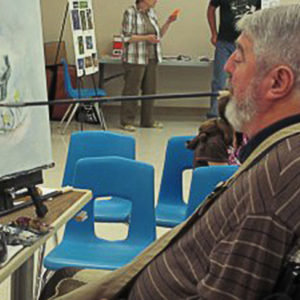calsfoundation@cals.org
Ronald Dale Tabor (1948–)
Since he was a child, Ronald Dale Tabor has been capturing the rustic scenery and the wildlife of the Ozarks on canvas. For most of his adult years, he painted without the use of his limbs. Tabor is a quadriplegic mouth-artist who taught himself to paint using his mouth after sustaining an injury in a near fatal car accident. He is one of the few Arkansans to gain membership in the Mouth and Foot Painting Artists of the United States (MFPA) and the International Mouth and Foot Painting Artists (IMFPA) based in Liechtenstein, Switzerland. Tabor is known for his realistic paintings of barns, wildlife, and the scenic outdoors of rural Arkansas.
Dale Tabor was born in Harrison (Boone County) on April 10, 1948, to Willard Tabor, a laborer/farmer, and Anna Mae Adams Tabor, a public school lunchroom supervisor. Tabor has an older brother and two sisters. He had an identical twin who died at birth.
From his earliest memories, Tabor had an affinity for art. One of his first recollections was as a three-year-old when he drew pictures on his mother’s chest-of-drawers with a nail. Throughout his school years, Tabor’s interest in art flourished. He utilized pastels and watercolors to complete sketches and paintings of animals and landscapes. In school, Tabor also excelled in athletics. As a high school senior, he averaged twenty-seven points per game on the basketball court. In 1967, he was selected to play on the Arkansas basketball All-Star Team. His athleticism merited him a scholarship to Arkansas Tech University.
At Tech, Tabor received his first formal art training. He discovered he enjoyed working with all media—acrylics, oils, pastels, and clays.
His college career was short lived. In 1968, during the Vietnam War, Tabor enlisted in the U.S. Army and was commissioned to active duty at Fort Benning, Georgia. During his training at Fort Benning, Tabor broke the fort record for running the mile. The previous record was set at 5:27, but Tabor completed the mile in 5:18. Tabor’s superiors made use of his artistic abilities by assigning him painting duties. Tabor and a fellow enlistee painted a mural of a country scene on the mess hall wall. Following his release from the army in 1968, he returned to Arkansas, settling in Pyatt (Marion County), where he married, gained a stepson, Justin, and fathered a son, Michael.
On August 16, 1969, Tabor was involved in a head-on collision with an oncoming vehicle and suffered an acute spinal cord injury. He spent August through December 1969 in a hospital in Little Rock (Pulaski County). In January 1970, Tabor was transferred to an institution that specialized in the treatment of injuries related to spinal cord trauma, the Texas Institute of Rehabilitation and Recovery (TIRR) in Houston. His prognosis was a complete cervical spinal cord injury, or C2 to C4 quadriplegia, causing complete paralysis; his jaw had also been broken, and his mouth was wired shut.
After April 1970, Tabor was released from rehab into the care of an uncle with a degree in chiropractic medicine in Kensett, Missouri. His uncle dedicated several hours each day to the treatment of Tabor’s back. After a few months, Tabor returned to his home near Pyatt. Hecontinued to receive treatments from rehabilitation centers in Hot Springs (Garland County) and through the TIRR.
During one of his extended stays at the rehabilitation center in Houston, Tabor listened to an inspirational speech by renowned quadriplegic speaker and artist Joni Earackson Tada and decided to attempt painting with his mouth. His progress was noted by hospital staff, who recommended him for a scholarship to the Museum of Fine Arts in Houston.
In the late 1970s and early 1980s, Tabor lectured at festivals and art conferences across Arkansas and demonstrated his method of painting. His paintings merited recognition at exhibitions in Eureka Springs (Carroll County) and at the Ozarks Heritage Arts Center. In the 1990s, he was a featured lecturer and instructor at the Ozarks Unlimited Resources Cooperative teacher training center in Harrison, and he served on the board for the Very Special Arts of Arkansas. Tabor displayed his paintings and lectured at the Kennedy Center in Washington DC; the Christopher Columbus Museum in Barcelona, Spain; and in galleries and international expositions in Austria, Canada, and Jamaica.
Through the MFPA, Tabor’s art has been circulated worldwide as reproductions on cards and in calendars. Most paintings were completed with acrylics, using oil for finishing touches. The majority of his art is realistic, as showcased in his depiction of Americana titled Treasures of the Past. Tabor’s work is distinguished for fine lines and detail work on pieces like the vibrant painting The Peacock, which he painted on a twenty-inch wooden panel. Prints of the popular painting have been duplicated and distributed through the MFPA.
Kate March, publicist and promoter at the Atlanta, Georgia, MFPA headquarters stated of Tabor’s work, “Dale’s talent and tenacity is less about transcending physical hurdles and is instead more about an honest and deep desire to demonstrate his tremendous abilities as an artist.”
Tabor is recognized throughout the Ozarks for his artwork and volunteerism. He visits local schools annually to demonstrate his technique, display his work, and share his inspirational story. He is often accompanied by his wife, Becki, and his Alaskan husky service dog, Silver.
For additional information:
Cothran, Beverly Kay. “Views through the Eyes and Mind of Artist Dale Tabor.” Harrison Daily Times, November 16, 2018. Online at http://harrisondaily.com/people/views-through-the-eyes-and-mind-of-artist-dale-tabor/article_1d82bbc2-ded2-11e8-9c84-3b611f1b6a9a.html (accessed June 28, 2019).
Dale Tabor Art. http://www.daletaborart.com/index.html (accessed June 28, 2019).
Mouth and Foot Painting Artists. http://www.mfpausa.com (accessed June 28, 2019).
Beverly Kay Cothran
Anderson Flat, Arkansas
 Arts, Culture, and Entertainment
Arts, Culture, and Entertainment Divergent Prosperity and the Arc of Reform, 1968–2022
Divergent Prosperity and the Arc of Reform, 1968–2022 Dale Tabor
Dale Tabor  Dale Tabor
Dale Tabor 




Comments
No comments on this entry yet.